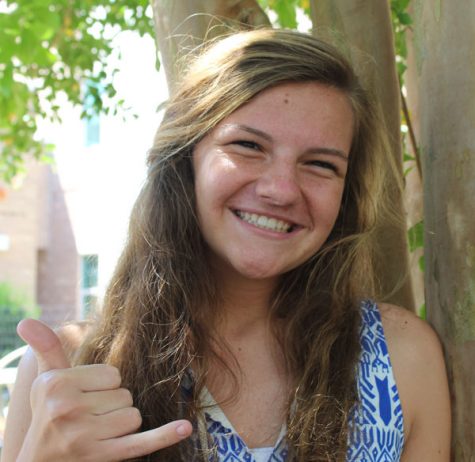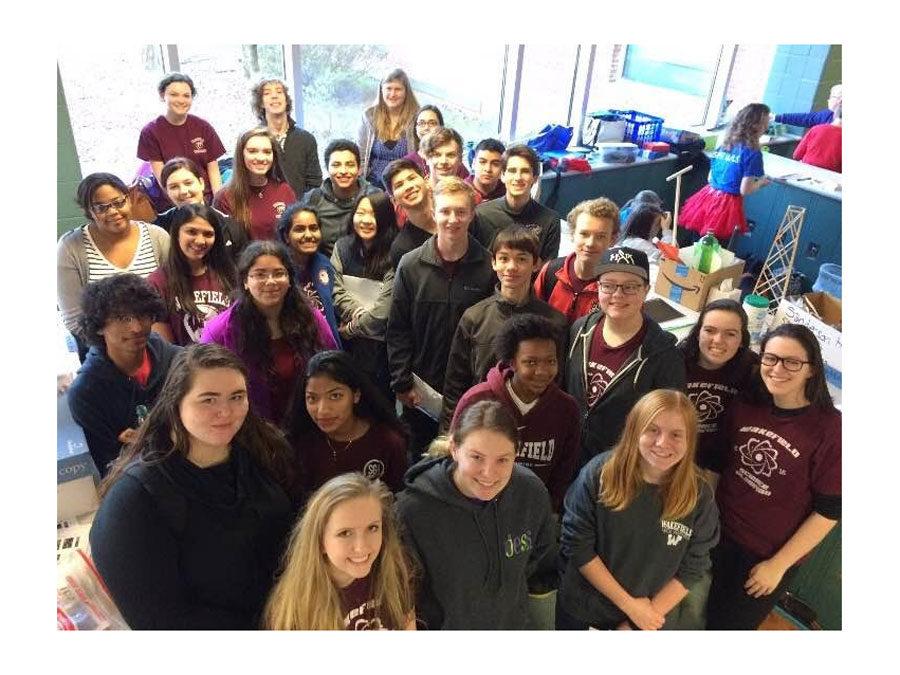Science Olympiads go for Au
The story behind the competition
Photo Courtesy of Kristen Hellier
Wakefield Olympiads prepare to hear competition results.
Science Olympiad: where students come together to compete in all different fields of science. The competition, which took place at Southeast Raleigh High School, was full of talented students from different high schools around North Carolina. There were many participants from Wakefield who had been practicing all year in order to place in the competition.
“[The competitors] did a lot on their own. They were very independent and got together with their teammates. [They] scheduled times when they could meet and work on answering questions or building their device, so they were really self-sufficient,” Science Olympiad advisor and science teacher Kristen Hellier said.
Advisors and competitors alike realized how much of a commitment preparing for the competition was.
“You have to put in at least ten hours per event if you even want a small chance at medaling, but even then you are still competing against [better prepared] teams,” senior and varsity Science Olympiad member Emma Robinson said.
Robinson competed in three different events: forensics, code busting, and invasive species, but these weren’t the only events available to compete in. There was a wide variety of activities within the event.
“I medaled in invasive species and also participated in Disease Detectives,” senior member Emily Hale said.
The advisors of the olympiads had their own favorite activities they observed during the competition.
“The duct tape challenge is always interesting because [the participants] are given a roll of duct tape and directions to build something that meets the standards,” science teacher and head Olympiad advisor Laura Stiles said. “That’s [an event] that they can’t really prepare much for because they don’t know what the exact challenge is going to be,” Stiles said, who enjoyed watching the challenges that required spur-of-the-moment thinking from students.
Hellier also commented on the excitement surrounding new events that were introduced to the competition this year.
“I thought hovercraft was a really neat new event,” Hellier said. “It was [great] to see how these kids put these things together. A lot of these events have been going on for quite a few years, so it was [interesting] to see how the [competitors] put their vehicles together.”
Medaling was no easy feat. The best science students from high schools all around North Carolina participated.
“Our regional competition is one of the hardest ones in the state. It definitely has a lot of very strong teams in the area, who have been doing it for a while…so the competition is pretty stiff,” Hellier said.
“The competition is getting harder. The program has grown in other schools within the county that are on the same level as us, and that has made it a lot more difficult for us,” Stiles said.
Although there were some tough competitors from the other high schools in the county, ten Wakefield students placed in the top three spots for their events within the competition.
Emily Hale, Jess Hudson, Anna Kim, Samuel Melhado, Gianna Pietri, Adam Yeh, Hannah Raftery, Tanvi Rane, Emma Robinson, and Tejal Vanukuru all placed in the top three spots for their events.
“[Winning] feels very rewarding! It’s a great feeling to know your hard work paid off,” Hale said.
Although medaling is an excellent achievement, members of Science Olympiad emphasize that winning is not the best part of participating in the competition.
“My favorite part [of the competition] is the feeling you get afterward,” Hale said.
Speaking from their experiences in this intense science event, senior members offer advice for future olympiads.
“Don’t regret anything after the competition because you did the best you can!” Hale said.
Robinson wants future members to focus on the more important parts of the competition: furthering your knowledge in science and having a fun time with fellow olympiads.
“The competition was fun because it’s like competing in any other sport. You feel like part of a team and you just have a good time with your teammates,” Robinson said.








